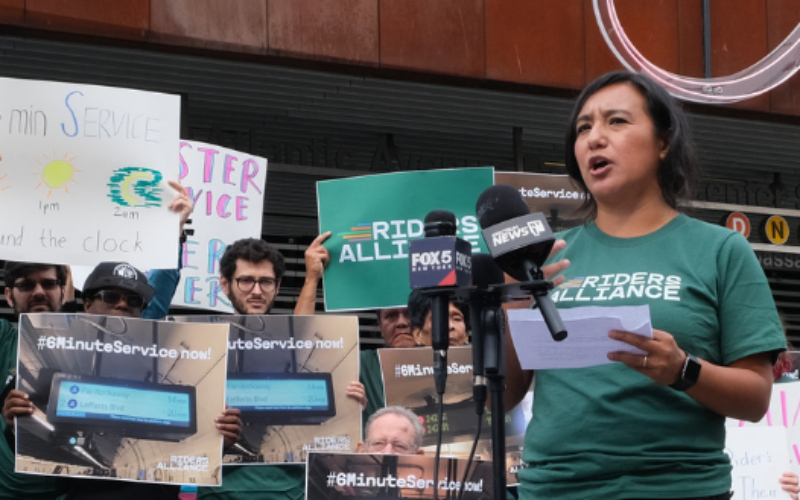

Civic technologists joined transit planning experts and advocates on March 5 for the first NYC Bus Data Hackathon, convened by TransitCenter, the NYU Rudin Center, and MTA New York City Transit. The session was designed to complement NYC Transit’s in-progress Staten Island Comprehensive Bus Study and provide a first step in identifying a menu of improvements that could apply across the vast NYC Transit bus system. NYC bus usage is down about 10% over the period 2004-2014.
MTA NYCT provided the 150 participants with a wealth of archival Bus Time data, Staten Island bus ridership data, survey results, origin and destination tables for express buses, and bus to subway transfer data for express buses. Participants also accessed publicly available resources like census and NYC taxi data. Tools and on-site technical support were provided by Google and CartoDB. Hackathon teams were charged with recommending routing, network design or operating changes to Staten Island local or express bus service, or both. The availability of increasingly fine-grained transit data allows agencies & civic partners to identify routes and locations most in need of fixes, as well as systemic issues requiring reform at basic levels.

TransitCenter executive director David Bragdon noted at the event’s outset that New York had addressed other transportation problems once seen as intractable, and that slow and unreliable local bus service was equally open to solution if attention and policy-making willpower were applied. He identified local bus improvements as a critical area for transit improvement in New York and across the U.S. (bus ridership is declining in several other key transit-based cities, as well as in New York). Staten Island Borough President James Oddo also spoke at the event’s kick-off, brandishing a mid-20th Century bus map. “Bus routes on Staten Island have remained unchanged from the 1960s, but the Island itself has undergone huge transformations,” he said As a result, “It’s a grind to get to work and get home from work. So last summer [Transit] labor & management and I got together and that led to the bus study.” The borough president lauded participants: “I am in awe of the talent in this room. It’s a wonderful thing to have you as allies in this struggle.”
Analyses contained in submissions from Hackathon participants identified:
- Concentrations of areas with heavy bus boarding or alighting
- High and lower ridership routes
- Corridors connecting high volume trip origins and destinations
- Intensive land uses not well served by the bus network
- Comparison of point to point auto and bus travel times to identify low-efficiency bus routes
- Identification of bus stops where actual performance varied widely from the service schedule
Recommendations stemming from the analyses included:
- Separating express routes destined for Lower Manhattan from those destined for Midtown, to reduce the considerable travel time S.I. express buses use driving through the Manhattan central business district
- Rationalizing express bus service in Staten Island into fewer high-frequency trunk routes
- Development of hub and spoke bus networks based on high ridership origins/destinations and trunk routes
- Alternate side parking restrictions on avenues to create additional peak-direction bus lanes
- Adjustments to routes and frequency of service on various local routes on Staten Island
- Have all express bus routes terminate in Lower Manhattan, with Midtown-destined passengers taking the subway to complete their trips
- An express bus route linking Staten Island to airports
Several teams also created analytical tools, seeking to enable the identification of more solutions rather than proposing specific ideas themselves — a key role for data scientists and software developers. One team, for example, developed a prototype for an interactive tool that would allow planners to see how the removal or addition of bus stops would influence passenger wait times and express and local buses.
Hackathon submissions can be viewed online at:
http://staten-i-bus-hackathon.devpost.com/submissions

Image From Sri Kanajan’s Grand Prize Winning Analysis
NYC Transit’s Jonathan Hawkins noted that “Many of the submissions had findings that were consistent with what we have been hearing so far from public feedback, particularly with regards to the complexity and length of the express bus routes.”
Compelling proposals produced at the Hackathon may inform Transit’s Staten Island Comprehensive Bus Study. The best solutions for faster, more effective transit will be presented publicly in Staten Island later this spring. The Staten Island Comprehensive Bus Study is scheduled to be issued in winter 2016-17.
The Staten Island hackathon and related outreach work is part of a larger effort at TransitCenter focused on developing an agenda for citywide local bus improvements.
 On the Brink: Will WMATA’s Progress Be Erased by 2024?
On the Brink: Will WMATA’s Progress Be Erased by 2024?
The experience of being a WMATA rider has substantially improved over the last 18 months, thanks to changes the agency has made like adding off-peak service and simplifying fares. Things are about to get even better with the launch of all-door boarding later this fall, overnight bus service on some lines starting in December, and an ambitious plan to redesign the Metrobus network. But all of this could go away by July 1, 2024.
Read More Built to Win: Riders Alliance Campaign Secures Funding for More Frequent Subway Service
Built to Win: Riders Alliance Campaign Secures Funding for More Frequent Subway Service
Thanks to Riders' Alliance successful #6MinuteService campaign, New York City subway riders will enjoy more frequent service on nights and weekends, starting this summer. In this post, we chronicle the group's winning strategies and tactics.
Read More